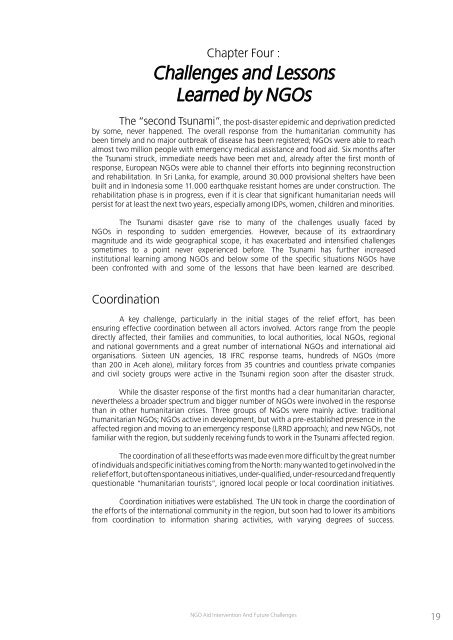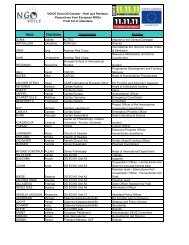Tsunami one year after, NGO aid intervention and future ... - VOICE
Tsunami one year after, NGO aid intervention and future ... - VOICE
Tsunami one year after, NGO aid intervention and future ... - VOICE
You also want an ePaper? Increase the reach of your titles
YUMPU automatically turns print PDFs into web optimized ePapers that Google loves.
Chapter Four :<br />
Challenges <strong>and</strong> Lessons<br />
Learned by <strong>NGO</strong>s<br />
The “second <strong>Tsunami</strong>”, the post-disaster epidemic <strong>and</strong> deprivation predicted<br />
by some, never happened. The overall response from the humanitarian community has<br />
been timely <strong>and</strong> no major outbreak of disease has been registered; <strong>NGO</strong>s were able to reach<br />
almost two million people with emergency medical assistance <strong>and</strong> food <strong>aid</strong>. Six months <strong>after</strong><br />
the <strong>Tsunami</strong> struck, immediate needs have been met <strong>and</strong>, already <strong>after</strong> the first month of<br />
response, European <strong>NGO</strong>s were able to channel their efforts into beginning reconstruction<br />
<strong>and</strong> rehabilitation. In Sri Lanka, for example, around 30.000 provisional shelters have been<br />
built <strong>and</strong> in Ind<strong>one</strong>sia some 11.000 earthquake resistant homes are under construction. The<br />
rehabilitation phase is in progress, even if it is clear that significant humanitarian needs will<br />
persist for at least the next two <strong>year</strong>s, especially among IDPs, women, children <strong>and</strong> minorities.<br />
The <strong>Tsunami</strong> disaster gave rise to many of the challenges usually faced by<br />
<strong>NGO</strong>s in responding to sudden emergencies. However, because of its extraordinary<br />
magnitude <strong>and</strong> its wide geographical scope, it has exacerbated <strong>and</strong> intensified challenges<br />
sometimes to a point never experienced before. The <strong>Tsunami</strong> has further increased<br />
institutional learning among <strong>NGO</strong>s <strong>and</strong> below some of the specific situations <strong>NGO</strong>s have<br />
been confronted with <strong>and</strong> some of the lessons that have been learned are described.<br />
Coordination<br />
A key challenge, particularly in the initial stages of the relief effort, has been<br />
ensuring effective coordination between all actors involved. Actors range from the people<br />
directly affected, their families <strong>and</strong> communities, to local authorities, local <strong>NGO</strong>s, regional<br />
<strong>and</strong> national governments <strong>and</strong> a great number of international <strong>NGO</strong>s <strong>and</strong> international <strong>aid</strong><br />
organisations. Sixteen UN agencies, 18 IFRC response teams, hundreds of <strong>NGO</strong>s (more<br />
than 200 in Aceh al<strong>one</strong>), military forces from 35 countries <strong>and</strong> countless private companies<br />
<strong>and</strong> civil society groups were active in the <strong>Tsunami</strong> region soon <strong>after</strong> the disaster struck.<br />
While the disaster response of the first months had a clear humanitarian character,<br />
nevertheless a broader spectrum <strong>and</strong> bigger number of <strong>NGO</strong>s were involved in the response<br />
than in other humanitarian crises. Three groups of <strong>NGO</strong>s were mainly active: traditional<br />
humanitarian <strong>NGO</strong>s; <strong>NGO</strong>s active in development, but with a pre-established presence in the<br />
affected region <strong>and</strong> moving to an emergency response (LRRD approach); <strong>and</strong> new <strong>NGO</strong>s, not<br />
familiar with the region, but suddenly receiving funds to work in the <strong>Tsunami</strong> affected region.<br />
The coordination of all these efforts was made even more difficult by the great number<br />
of individuals <strong>and</strong> specific initiatives coming from the North: many wanted to get involved in the<br />
relief effort, but often spontaneous initiatives, under-qualified, under-resourced <strong>and</strong> frequently<br />
questionable “humanitarian tourists”, ignored local people or local coordination initiatives.<br />
Coordination initiatives were established. The UN took in charge the coordination of<br />
the efforts of the international community in the region, but soon had to lower its ambitions<br />
from coordination to information sharing activities, with varying degrees of success.<br />
<strong>NGO</strong> Aid Intervention And Future Challenges<br />
19






